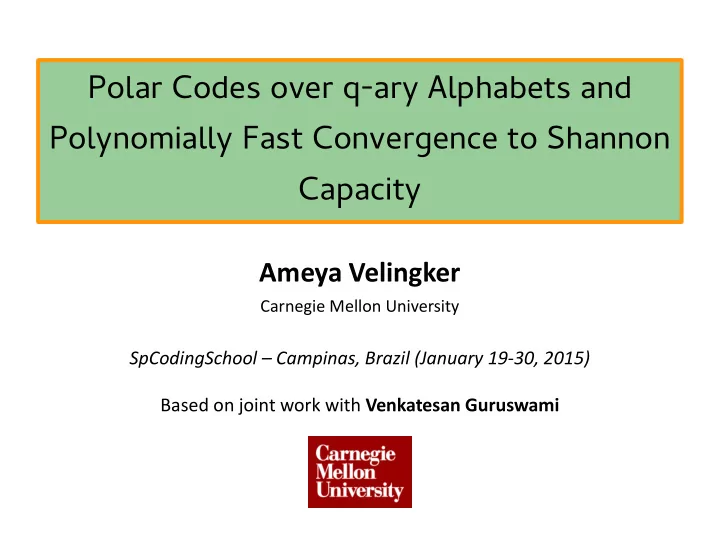

P o l a r C o d e s o v e r q - a r y A l p h a b e t s a n d P o l y n o m i a l l y F a s t C o n v e r g e n c e t o S h a n n o n C a p a c i t y Ameya Velingker Carnegie Mellon University SpCodingSchool – Campinas, Brazil (January 19-30, 2015) Based on joint work with Venkatesan Guruswami
Channel Capacity Theorem ( Shannon's Noisy-Channel Coding Theorem , 1948). For any discrete memoryless channel W, there exists an associated nonnegatjve constant I(W), known as the channel capacity such that: For any ε > 0, one can communicate at asymptotjc rate R = I(W) - ε with vanishing probability of miscommunicatjon. For any R > I(W) , it is impossible to communicate at a rate R without non-negligible probability of miscommunicatjon. For rate R = I(W) – ε, the gap to capacity is ε. Challenge : Construct explicit coding schemes (with effjcient encoding and decoding procedures) that obtain arbitrarily small gap to capacity!
Binary Polar Codes ● Polar codes give the fjrst known constructjon to achieve capacity with the aforementjoned guarantees ⇾ ∞ ● Rate approaches I(W) as N ● O(N log N) complexity ● For polar codes over binary alphabet, [Guruswami-Xia '13] and [Hassani-Alishahi-Urbanke '13] independently show the speed of convergence to capacity – There is an absolute constant c such that any block length N ≥ (1/ε) c will yield a rate of at least I(W) – ε Questjon : What about polar codes over non-binary alphabets?
Main Result ● We extend the work of [Guruswami-Xia '13] to q-ary polar codes for any q > 2 ● q-ary polar codes are the fjrst explicit deterministjc constructjon of q-ary codes approaching the capacity of q- ary symmetric DMCs with provable guarantees – Encoding and decoding complexity polynomial in block length N – Constant c = c(q) such that rate ≥ I(W) - ε for N ≥ (1/ε) c – Decoding error probability exp(-N 0.49 )
Recommend
More recommend